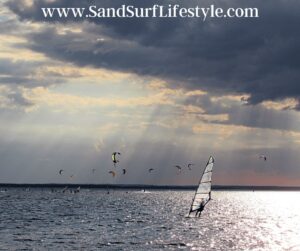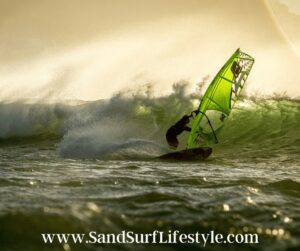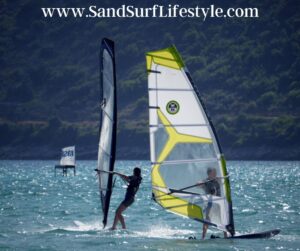Windsurfing is a great sport and many people enjoy watching windsurfers perform. There is a lot more that goes into windsurfing than just standing on a windsurfing board and letting the wind guide you on the ocean. You must have proper technique, especially when performing more advanced moves.
Practice Makes Perfect
Whether you are a beginner starting to learn the correct way to windsurf or have been windsurfing for years and trying to learn more advanced tricks it is important to have the right form and techniques when doing any type of windsurfing.
 Using the correct techniques will not only help you stay on the windsurfing board better and prevent you from going flying off the windsurfing board into the water every time there is a big gush of wind or you are trying to turn. Using correct form and technique will also keep you safe and prevent serious injuries from occurring.
Using the correct techniques will not only help you stay on the windsurfing board better and prevent you from going flying off the windsurfing board into the water every time there is a big gush of wind or you are trying to turn. Using correct form and technique will also keep you safe and prevent serious injuries from occurring.
Windsurfing can be a dangerous sport and not following the right technique can cause you to get injured.
Injuries from windsurfing vary from small bumps and bruises to medical emergencies that require immediate medical attention. Some common injuries that occur due to improper technique when windsurfing include:
- Shoulder dislocations
- Concussions
- Pulled muscles (especially common in the lower back when improper technique and form is used)
- Rib fractures
- Bruising
- Sprains
- Jellyfish stings
- Abrasions
- Sunburn
Perfect Your Stance
Having the correct stance will make windsurfing much easier. If your stance is off then you may fall over onto the board or fall off the board and into the water while windsurfing.
The best way to stand while windsurfing is with your feet shoulder-width apart and your back foot should be pointed out and your front foot should be pointed to the tip of the board. Your feet should make an “L” shape.
Your feet should be near the center of the windsurfing board close to where the sail and mast are located.
If you notice that the board is sinking into the water on the back of the board then take a step or two forwards, and if you notice that the front of the board is dipping into the water then take a step backward.
Steering is Not As Easy as it May Seem
Steering is a vital part of windsurfing. If you do not know how to steer correctly you will not be very successful windsurfing. There are two types of steering in windsurfing, upwind steering and downwind steering.
Upwind Steering
Upwind steering is typically easier for people than downwind steering. When steering upwind you will bring the lower corner of the sail that attaches to the boom, also sometimes referred to as the clew, towards the back of the windsurfing board.
Downwind Steering
 Downwind steering can be a bit more tricky especially for beginners. Since you are steering against the direction of the wind you will want to tilt the windsurfing sail forwards and across the windsurfing board. You will keep the sail of the windsurfing board across the board until you are facing the direction that you are wanting to go.
Downwind steering can be a bit more tricky especially for beginners. Since you are steering against the direction of the wind you will want to tilt the windsurfing sail forwards and across the windsurfing board. You will keep the sail of the windsurfing board across the board until you are facing the direction that you are wanting to go.
Twisting and Turning
Once you get the hang of steering upwind and downwind then you can work on turning while windsurfing. There are two types of turns in windsurfing. An upwind turn is referred to as a Tack and a downwind turn is also known as a Gybe.
The Tack Turn
Similar to steering, the tack turn, or upwind turn, is easier than a downwind turn. In order to do a tack turn the nose of the windsurfing board should turn the same direction as the wind is going. The tack turn is great for beginners to learn first and start to practice and get comfortable turning before moving on to the Gybe turn, or downwind turn.
To start a tack turn start to steer your windsurfing board upwind. Once you have your windsurfing board moving upwind then grab the mast from underneath the boom. Then move your feet so that they are on both sides of the mast of the windsurfing board and make a 90-degree angle with the windsurfing board.
Once you have your hands and feet in the correct position then you can slowly start moving your feet and move the sail of the windsurfing board while you step. By doing this you will make a turn. While turning, bend your knees and back straight to make the turn a little easier.
Return to your starting position once you have completed your turn.
The Gybe Turn
 The Gybe turn is more difficult and may take more practice to get the hang of it. In order to do a Gybe turn, you will be turning the front of the windsurfing board in the opposite direction of the wind.
The Gybe turn is more difficult and may take more practice to get the hang of it. In order to do a Gybe turn, you will be turning the front of the windsurfing board in the opposite direction of the wind.
To start a Gybe turn you will move your backhand down the sail of the windsurfing board and grab low on the boom.
Next, you will move your feet. Move your back foot towards the back of the windsurfing board by doing this the sail should open up.
Once the sail is opened up then you will want to switch where your feet are. Move your back foot first to where your front foot is located then move your front foot back to where your back foot was located. See why the Gybe turn is so difficult! Switching your feet can be the most difficult part of the Gybe turn and where many people lose their balance and fall in.
Time To Speed Things Up
Once you feel comfortable with the basics of proper standing, steering, and comfortable with turns then it is time to move faster. Going fast makes windsurfing even more fun. In windsurfing, speeding up and moving fast across the water is also referred to as planing.
Whenever you are windsurfing, having a good grip is important but it becomes even more vital when you are ready to turn up the speed while windsurfing.
The strength of the wind that you are windsurfing in will play a big part in how fast you will be able to windsurf. In stronger winds, you will be able to sail a lot faster across the water than in calmer winds. When windsurfing in stronger winds it is recommended to keep your head down slightly to allow for more control while you are windsurfing. In calmer winds then it is recommended that you keep your head up more, which will allow you to have more power through the wind.
To start going faster and planing you will want to adjust where the weight of your body is distributed on the windsurfing board. Bend your back leg but keep your front leg straight and shift your weight slightly to your front leg. Be careful not to put all your weight into your front leg or else you may rock your windsurfing board too far forward and you may do a face plant into the water.
When gliding fast across the water, have your front arm extended out in front of you and keep the sail of the windsurfing board out away from your body.
Not sure how to plane while windsurfing?
Here are 5 techniques you can try.
How Much Wind is Needed to Go Windsurfing?
The good thing about windsurfing is even if it’s not very windy outside you can still enjoy windsurfing. For basic windsurfing, all you need is about 5 MPH of wind and you will be able to go out and enjoy windsurfing.
For beginner windsurfers, more than 15 MPH of wind can be a little tougher to learn and may take more practice. While for more advanced windsurfers, can enjoy windsurfing in winds that are 35 MPH or faster.
Show Off Your Moves
Once you mastered gliding faster on the water you may want to add some tricks to your windsurfing. There are numerous tricks that you can learn how to do while windsurfing. Some common tricks to start with when windsurfing include:
- The Vulcan
- The Forward Loop
The Vulcan
 One windsurfing trick that many people start with is known as the Vulcan. This is considered by windsurfers as a beginner aerial freestyle move.
One windsurfing trick that many people start with is known as the Vulcan. This is considered by windsurfers as a beginner aerial freestyle move.
When you do a Vulcan you “pop” the top of the windsurfing board up out of the water and keep the bottom of the windsurfing board in the water. Think of it almost like a wheelie on a skateboard but in the water for a windsurfing board.
To do the Vulcon you will move your front hand to the mast and unhook the crouch, when you do this then the board will “pop” up in the water. To get more height from this pop then you should let go with your backhand and switch your backhand and front hand locations. So your backhand will become your new front hand and your front hand will become your backhand.
Once the board has landed back into the water then switch your hands back to the original position.
Do not worry you may fall a few times learning how to do this move, just get back up and try again and you will get it with enough practice.
The Forward Loop
Everyone loves to stare in amazement when they see someone complete a forward loop. They look like the person is flying over the water and, most of the time people who are doing forward loops make them seem so easily done!
In order to complete a successful forward loop, it is important that you have the right mindset. A lot of times if someone thinks they are going to fall while trying to complete this trick then they do fall into the water.
You may fall quite a few times trying this move, shake it off and get back up on your windsurfing board and try it again and again until you can complete it. You will be glad you did when you finally land your first forward loop.
When starting a forward loop start by crouching down and sliding your backhand to the back of the boom. Next, you will pop your windsurfing board up in the water and extend your front arm out in front of you. After you have your front arm out in front of you then you can tuck your body and the board close to you and flip.
Once you have completed the loop then you can bring the windsurfing sail back to an upright position and return to the stance you started with. Landing can be difficult but, you will feel on top of the world when you finally stick your landing for your first forward loop.
Go Out And Start Catching Some Waves Windsurfing
Windsurfing is a great workout and a lot of fun once you get the hang of it. Even if you fall in the water just get back up and keep trying and you will get the hang of it. Use these techniques when it comes to standing, steering, turning, and working on new tricks and skills and you will get better with windsurfing.
Please note: This blog post is for educational purposes only and does not constitute legal or medical advice. Please consult a legal expert or medical professional to address your specific needs.

